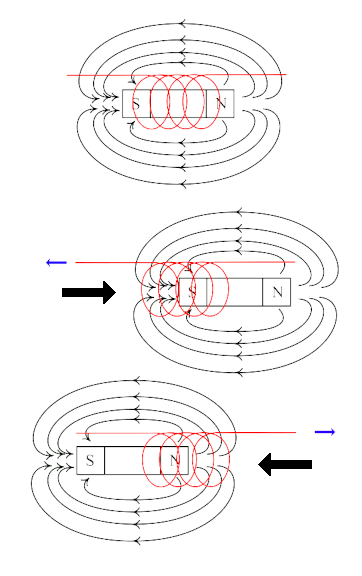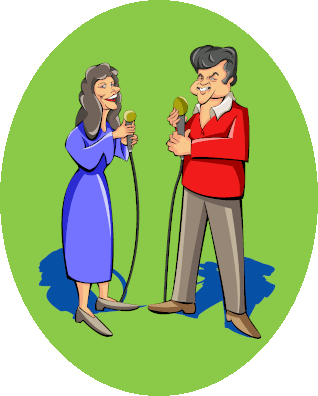Bo Diddley
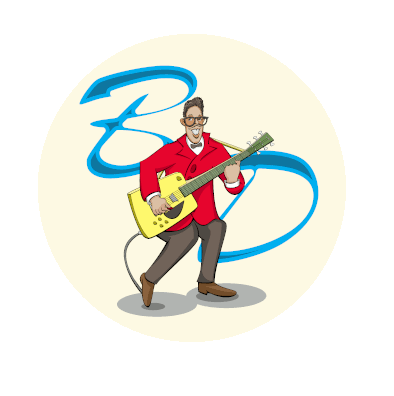
(Click on the image to zoom in.)
According to contemporary lore, when a group of four young men from Liverpool came to the United States to appear on the telly, they were asked what they wanted to see in America. "Bo Diddly" was the immediate answer. When the reporters expressed ignorance of the gentleman so named, the young men laughed. "You don't even know your own heroes!" they said.1
The source of the story is often cited as the first press conference on February 7, 1964, when the Beatles arrived at John F. Kennedy Airport in New York, and it was John Lennon who gave the answer. However, transcripts and video footage so far examined don't have that particular conversation.

The Fab(ulous) Four
Ellas Otha Bates was born on December 30, 1928, in McComb, Mississippi. That's about 75 miles south of Jackson and 100 miles north of New Orleans. His mother was unable to care for the infant and Ellas was taken into the family of his mother's cousin, Gussie McDaniel. Gussie lived in Chicago and Young Ellas took the McDaniel family name as his own.
Somewhere along the line Ellas McDaniel became Bo Diddley. Like so much of what we read about Bo (as we'll call him from now on), there are a number of tellings. Bo himself said it was just a nickname his chums gave him. But scholars have also pointed out that one of the African folk instruments imported to America was the "diddley bow".
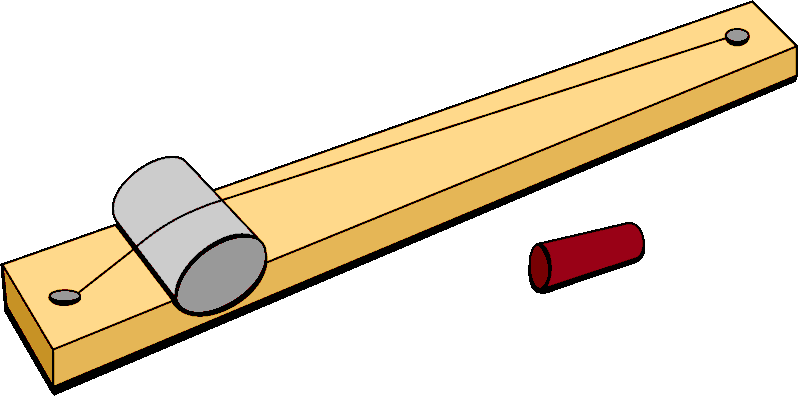
The Bow, Diddley
A diddley bow is a single stringed instrument made by attaching a wire onto a wooden board. A bottle or metal can is placed under the string to act as a bridge and resonator and different notes are sounded by using a metal or glass slide as in playing a slide guitar. More high end diddley bows are of fairly sophisticated construction - some have a basic banjo look - and in the hands of a virtuoso can produce impressive music. Because of its ease of construction and the ready availability of the needed materials, the diddley bow is one of the first instruments the young aspiring blues players traditionally learned.
Chicago was a musical city, and then as now music was an important part of African American culture. Early on Bo found he had talent and he became proficient on the violin and even took formal lessons. He learned to read what he later called "funny music like Tchaikovsky." He also learned to play drums and trombone.
Part of the problem with playing the violin is that if your hands are too big they can get in the way of themselves. Bo had big hands and thick fingers - "meat hooks" he called them. That he also took up boxing didn't slim down his phalanges any.
Besides Bo really liked the guitar. So when his big sister, Lucille, bought him one for Christmas he was ecstatic, even though Gussie, in loco parentis, didn't approve of him switching from sophisticated and proper instruments to just banging on an "axe". But Bo went ahead and learned to play the guitar anyway.
Chicago wasn't just a city of music, it was the city of the 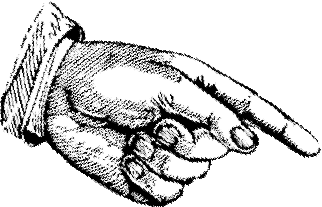 BLUES. And most of all it was a city of the electric blues.
BLUES. And most of all it was a city of the electric blues.
The guitar is a notoriously quiet instrument. Violins, violas, double basses, and banjos can be easily heard unamplified. But if you put a guitarist on a stage, then good luck trying to hear.
The lack of projection of the guitar is a problem for an audience trying to hear traditional performers who eschew the impurities of (ptui) amplified sound. Certainly Andrés Segovia's insistence that he was never to be "miked" produced decidedly mixed impressions with the audience. When a television host remarked he once heard Segovia at a live concert, guitarist Sharin Isbin asked, "You actually heard him?"
Even John Williams, perhaps the most technically adept of the modern classical guitarists, remarked on attending Andrés's unelectrified performances. "Once you get past the magic of the great old man walking on the stage and all the history that goes with it, it was ridiculous, to be honest. You'd be sitting in the back of the festival hall, and you'd hear the odd little plink and plonk. It was magic but it wasn't music."2
When Andrés was once playing with an orchestra at Constitution Hall in Washington, D. C., a microphone was planted surreptitiously. A fellow guitarist in attendance immediately realized what had happened given how clear the notes were. The effect, he said, was excellent and the guitar was easily heard even in passages when the orchestra was playing along. But when Andrés found out about the subterfuge, he was livid and vowed never to play there again.
There was one performance, though, where Andrés evidently agreed to be amplified. This was when he performed at the Valley Forge Music Fair outside of Philadelphia in the 1980's. This was a "theater in the round" where the stage slowly rotated so everyone could get an equal amount of viewing. Andrés certainly knew that in that situation the music could not be heard unless it was enhanced.
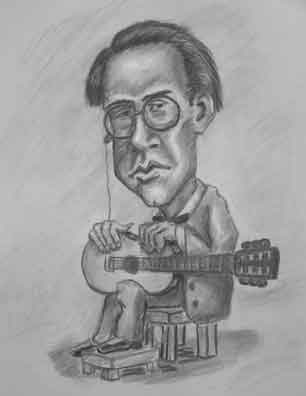
Andres Segovia
Playing the Plink and Plonk
Naturally the solution was just to invent a louder guitar. So in the 1890's someone created the f-hole guitar, also called the arch top, which borrowed some of the design from the violin. And arch tops are a bit louder than the flat-tops. Then about 30 years later the resonator guitar appeared (often called the Nashville steel guitar and not to be confused with the pedal steel instrument). This was certainly a step in the right direction. But the performer still had to practically shout the words out and whang the guitar almost to destruction. So what to do?
There was just one word.
Electricity.
Man-made electricity had been around since Thales of Miletus discovered you could rub a piece of fur on a chunk of amber and the amber would pick up pieces of hair and cloth. But it wasn't until the 1660's that Otto von Guericke of Germany created a static electric generator that could deliberately transfer charge onto a metal sphere. Then when Alessandro Volta invented the battery it was possible to send electric current through a wire. This voltaic pile was followed by the first electric generator in 1831 when Michael Faraday demonstrated he could produce direct current by turning a metal wheel in a magnetic field.
By the late 1800's electrical companies were providing electricity to homes and businesses primarily for lighting and other appliances. Then in 1906, the American inventor Lee de Forest introduced a triode vacuum tube intended to be a receiver for radio signals. A few years later it was recognized that the triode tubes could act as general amplifiers for electrical signals, and by 1920, public address systems as we know them had been installed in convention centers, hotels, train stations, and baseball parks. Soon portable PA equipment was available, and you could speak louder at almost any place you could find an electric socket.
Musicians immediately saw that they could now increase the volume of their voices and their instruments many times over. But the problem for guitarists was that although you could put a microphone next to your guitar strings, and it would pick up the music, you could also hear any words inadvertently spoken as well. So the goal became to find a microphone that would pick up only the music.
Michael's Induction
Musical Induction
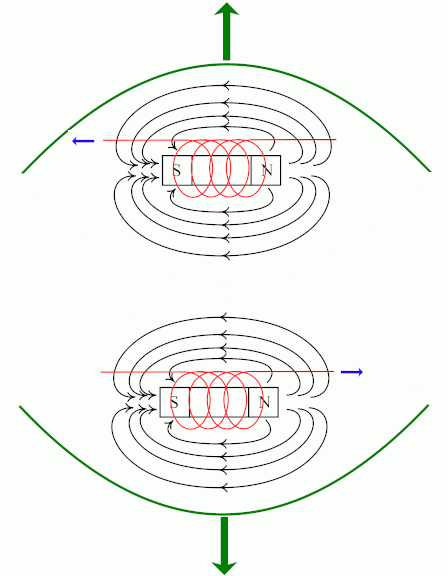
The principle of the electric generator came to the rescue. If moving a magnet through a coil of wires will cause current to flow, you ought to get current from a metal string vibrating next to a magnet. So just wrap some insulated wire around the magnet, pluck the string, you'd get current that could be sent to an amplifier.
Since the alternating current would be the same frequency as the vibrating string, once you hooked the amplifier up to a speaker, you'd get the same note as the string and pretty much as loud as you wanted. And any sotto voce imprecations voiced by the performer wouldn't be picked up.
For bluesmen, amplification was the ticket. Their music could be heard in clubs and theaters no matter how large and they could even run an extension chord through a window if they wanted to play on the streets. The electronics of the guitars could also be altered so that a variety of sounds could be produced that were impossible to create with the acoustic instruments.
Getting an electric guitar and the amplifiers, though, wasn't easy. After all they weren't cheap - even in the early 1950's a guitar and amplifier could run hundreds of dollars.
But for Bo, who had a knack for electronics, the solution was simple. He'd just make his own. Shoot, the principle was easy enough. Just cut a block of wood, put on a finger board, add the pick-ups, and you've got your guitar.
That was typical of Bo's modus musicerandi. If you didn't have something, you just made it. When he needed some maracas, rather than buy them he just found some old plumbing fixtures. He took a couple of float balls, put in some pebbles, added the handles, and hey, presto!, he had maracas. It was Bo's originality in his music together with his inventiveness that landed him the sobriquet, The Originator.
Bo's guitar was certainly distinctive. Instead of making the body look like an acoustic guitar - which was a common design at the time - he just cut out a rectangular slab of wood and added the necessary accoutrements. For an amplifier he modified a radio so he could plug in the guitar. Dang if the thing didn't work.
As far as finding performing venues, Bo decided he'd take direct action. He and his band would just set up on a street corner and begin to play. They'd put out the hat and after a day's performance, he and his buddies would generally have some change to divide between them.
Bo's big break came when he was twenty-three. He and his band were playing on the sidewalk when a theater owner came up and told them to come in and perform for an amateur contest. They won and got $15. The next week they went back and won again.
After realizing he had the ability to make money with his music, Bo again took the direct approach. He just walked into some of Chicago's recording studios and asked to cut some sides. Although some of the companies weren't interested in a musician with a homemade guitar, Bo found the owners of Chess Records were willing to give him a try. The Chess brothers, Leonard and Phil, liked what they heard and the first record Bo Diddley made - the eponymous "Bo Diddley" - was enough to land him a contract.
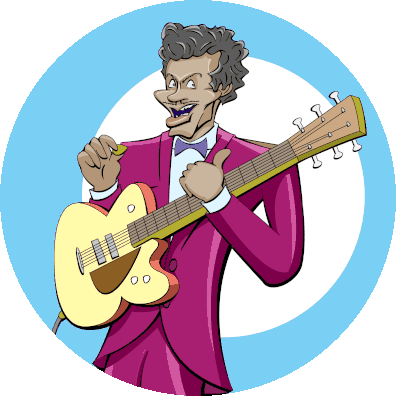
Chuck Berry
Another Artist
One surprise to those who know of Bo as one of the icons of rock and roll is that his records were never big sellers, certainly not like those of other Chess artists like Chuck Berry. But Bo's songs were closely rooted in the blues while Chuck's tunes were what critics call "accessible". When he began performing Chuck played "rockabilly". In fact Chuck's song "Johnny B. Goode" was the first song ever sung on the long running country music show Hee Haw - and performed by Buck Owens and his Buckeroos, no less. So Chuck's songs could do treble duty as country or rock and roll or pop.
Given his location and his choice of instrument, it's no surprise that Bo's songs were not just the blues they were the Chicago Blues. the electrified descendant of the indigenous music of the Mississippi Delta. As hard as it to sit still when listening to Bo's playing, it must be admitted that the Chicago blues isn't everyone's cup of coffee. For one thing, it's loud and the electronic effects with the deliberate tone distortion and feedback are something that fans of acoustic blues can find distracting.
On the other hand, Bo developed a pattern now called the "Bo Diddley beat" which became one of the fundamental rhythms for rock and roll. So like the way historians cite Fats Waller as the one who connected ragtime piano with jazz, so Bo is often credited for connecting the blues with rock and roll.
The Bo Diddley beat has its roots in the indigenous West African percussion music which was imported to the Americas by the enslaved people. Because the slaves were forbidden to play drums on the plantations - a remnant of their - quote - "heathen religion" - unquote - they developed the "juba" pat where they created the rhythms by slapping parts of their body.
The juba pat produced what musicologists call the "clave" pattern and is also known and the "hambone", or "shave-and-a-haircut" beat. In Bo's hands it became his characteristic, "BOMP, bomp-a BOMP, bomp-a, BOMP-a BOMP, BOMP" rhythm. As to where Bo got the beat he said he learned it from church music. At other times he said he learned the rhythm from trying to play a Gene Autry song.
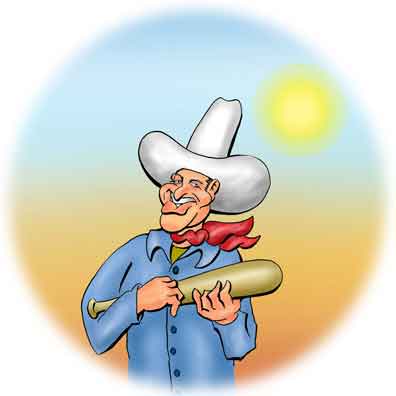
Gene Autry
The Original Originator?
Bo's songs tended to have a strong repetitive drive and some of the tunes could be pretty wild. True, a lot of the kids liked Elvis's gyrations, but they also liked the calmer crooners - Bobby Darin, Fabian Forte, Johnny Mathis, Bobby Rydell. And in the 1950's racial mixing, even culturally, was still frowned on and the idea of their delicate young bobby-soxers listening to Fats Domino singing about the thrill he found on Blueberry Hill filled many parents with horror. Far better was for the girls to listen to Ricky Nelson's "Hey, Mary Lou", Fabian's "This Friendly World", or lay around their bedrooms blubbering over J. Frank Wilson's "Last Kiss".
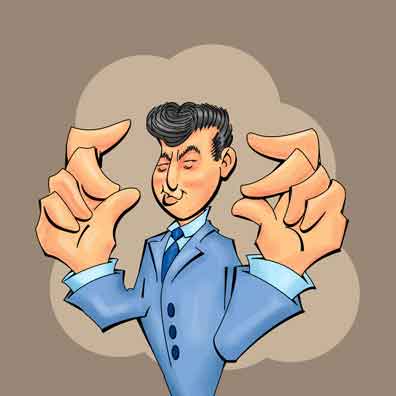
Bobby Darain
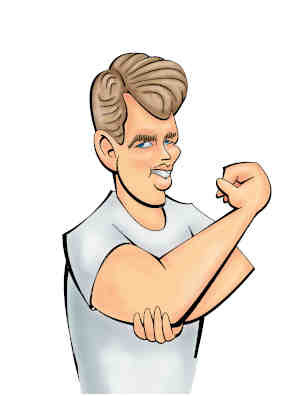
Fabian
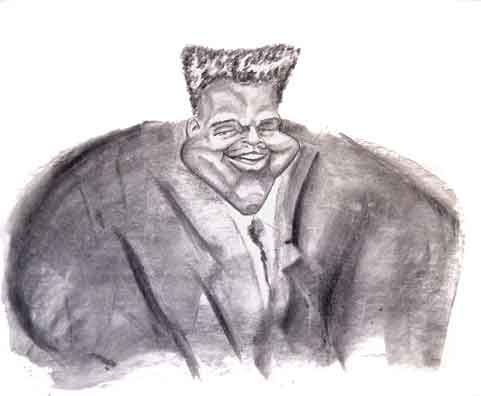
Fats Domino
Throughout his career Bo Diddley had only 5 songs on Billboard's Top 100 and he never broached the Top 10. Of the five songs listed, it was only "Say Man" that reached the Top 20. This was more of a novelty tune and was actually a comic conversation with Bo and his sideman trading barbs.
Bo's other four songs on the Top 100 were "You Can't Judge A Book By The Cover" (which reached #48), " "Crackin' Up (#62)", "Road Runner" (#75), and "Ooh, Baby" (#88). Considering all the songs and artists in the 1950's and 60's who registered higher in Billboard's Top 100 - among the #1 Hits of the Top 100 are the likes of "Surf City" by Jan and Dean, "Dominique" by the Singing Nun, "Windy" by the Association, "Winchester Cathedral" by the New Vaudeville Band, "Leader of the Pack" by The Shangri-Las, "Christmas Don't Be Late" by David Saville and the Chipmunks, "Judy in Disguise (With Glasses)" by John Fred and His Playboy Band, "The Streak" by Ray Stevens, and "The Monster Mash" by Boris Pickett and the Crypt Kickers - we naturally wonder why scholars list Bo Diddley as one of the founders of rock and roll.
No doubt you have, as Captain Mephisto said to Sidney Brand. It's very simple really.
The trouble is it's hard to write history until it's done. And one place Bo's songs found a receptive audience was in England with the scruffy bunch of kids who were trying to import rock and roll from the Colonies. In amongst this group were the likes of Mick Jagger, Keith Richards, Brian Jones, Eric Burdon, Peter Townshend, Eric Clapton, and a quartet of four youths from Liverpool. True, there were American singers who knew of Bo's importance as well, including a young Texan from Lubbock named Charles "Buddy" Holley (who later dropped the "e"). Buddy recorded a quite credible rendering of "Bo Diddley", but when you get down to it, it was the Albionic Invasion with their incorporation of the styles of Bo, Chuck Berry, and Little Richard that ultimately made rock and roll part of world culture.
And if any one doubts Bo's influence on the English musicians, listen to his song "Say, Boss Man":
I got nineteen kids at home gotta eat.
Eighteen of 'em need shoes on their feet.
Boss man, can't you see?
All nineteen kids I've got to feed!
... then go watch the last scene of Magical Mystery Tour where all the men go to a - well, to a "nightclub". Although some think the Bonzo Dog Doo-Dah Band singing "Death Car for Cutie" is a satirical imitation of Elvis, as far as the fundamental beat and style, it's clearly Bo.
By the way, if you look at his records you won't see Bo Diddley as the composer. Instead, they were credited to E. MacDaniels. For the same reason if you look at the records of Conway Twitty, you'll see some were written by someone named Jenkins.
Today with the world wide entertainment venues literally being carried in your pocket, it's forgotten that before the digital age, celebrities from one country would be virtually unknown in another even when - to paraphrase Oscar Wilde - they are divided by a common language. That was particularly true with the early English and American television hosts ("presenters" in the British patois). The likes of Johnny Carson, Dick Cavett, Bob Barker, and Merv Griffin were virtually unknown to English viewers. Nor did many Americans know of Michael Parkinson, Nan Winton, Bruce Forsyth, Bob Monkhouse, Jon Pertwee, Nicholas Parsons, Mary Berry, or even Sir Terry Wogan.3 Once when Ed Sullivan was filming a special in England, a member of the crew asked "who's the guy with no neck who can't talk?"
Sir Terry, among his other accomplishments, made one of the longest putts in golf history. He was participating in a celebrity golf competition in 1981 at Gleneagles, Scotland, when he holed a 100 foot putt. This was the longest put ever televised until 2012 when Olympic medalist Michael Phelps sank a 159 foot putt at the Alfred Dunhill Pro-Am Championship. There have been longer putts made but none televised.
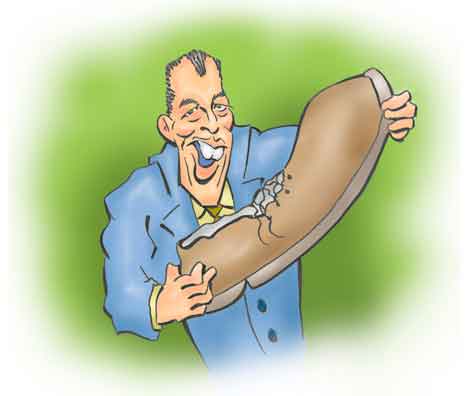
Ed Sullivan
A Really Big Shew
But in America you could rise no higher than to be on The Ed Sullivan Show which was one of the most watched programs from 1948 to 1971. Although when Ed began broadcasting his really big shew, segregation was the law of the land, he featured black performers from the first. Over the years the audience saw performers like Cab Calloway (who first appeared on the show in 1948), Lena Horne (also first on in 1948), Count Basie (also 1948), Sammy Davis, Jr. (1951), Eartha Kitt (1952), Harry Belafonte (1953), Della Reese (1957), Ella Fitzgerald (1957), and of course many more.
On the other hand, Ed was still - to use a trite expression - "a product of his times" and he could go beyond the bounds of good taste. He was also very sensitive that his show should not stray from - to use an ever triter expression - "American family values". If the performers ventured from that narrow path, they could incur Ed's permanent wrath. This was evident in his dealings with Bo.
In 1955 Bo had been scheduled to appear on November 20. Naturally he planned to play his signature song "Bo Diddley". Now there's really nothing objectionable to the song so exactly what was Ed's beef no one knows. But clearly he had second thoughts that the tune might not be fully d'accord with his audience's expectations.
So just before he went on the air - and remember the show was live - Ed told Bo that he had to play "Sixteen Tons" instead. This song was about as far from Bo's genre as possible but it had been a big hit when released by the eminently respectable Tennessee Ernie Ford.
Bo didn't know the song. Well, no problem, said Ed. He'd just get someone to write up cue cards with the lyrics. No sweat.
Bo later said there had been a misunderstanding and he seems to have thought Ed meant he'd play two songs. One would be of his own choice and then he'd follow that by "Sixteen Tons". So Bo and the group went on and sang "Bo Diddley".
Misunderstanding or not, Ed had a cow. After the performance he stormed up to Bo and said that Bo was - and this is the quote - "the first black boy that ever double-crossed me". Whether Ed was just not aware of it or what, but the word "boy" was (and is) one of the worst insults Ed could have hurled. Also implied in the statement was that being "double-crossed" by a black man was worse than being double-crossed by a white man.4
Bo later recorded a version of "Sixteen Tons". It was, though, a hipped up Chicago blues version which would also have been guaranteed to rise Ed's wrath. We suspect that Bo crafted his arrangement specifically with Ed in mind.
Ed had gotten Bo's dander up. "I was ready to fall on the dude," he later said and even had to be pulled back before his pugilistic training took over. Ed then foamed that he would make sure that Bo never appeared on television again.5
Bo wasn't the only performer to incur Ed's wrath for playing something Ed didn't like. The most famous instance was when the Doors appeared on Ed's show in 1967 and were going to sing "Light My Fire". Ed thought the lyrics "Girl, we couldn't get much higher" could be taken as a reference to drug use. He said they had to change the word "higher" to "finer". The group agreed knowing full well they were going to sing the original lyrics which they did.
After the show when Ed stormed up, the group played dumb and said it was simply the excitement of appearing on the Ed Sullivan Show that got them flustered and so they sang the original lyrics. Ed didn't believe a word of it and yelled they'd never appear on television again. He was wrong, of course, and the group appeared later on the Jonathan Winters Show and the Smothers Brothers Comedy Hour.
Less famous and with less controversy was when the Irish folk group, The Dubliners, were guests in 1968. They were going to sing the humorous song "Seven Drunken Nights" which tells the story of a husband who comes home drunk each night to find evidence that his wife is not adhering to traditional Irish family values. She gives him the excuse that he's so drunk he can't tell things like a pig from a horse, a pipe from a tin whistle, or a pair of boots from a geranium pot. But it was the last verse that Ed completely and vehemently vetoed. Rather than raise Ed's choler, the group sang "Mursheen Durkin" instead.
There was one case when a singer simply refused to go on although in this case it wasn't necessarily due to an objection specifically from Ed. Bob Dylan had been scheduled to appear on May 12, 1963. But after the rehearsal, one of the CBS executives objected to his satirical "Talking John Birch Blues", one of Bob's few truly political songs. Rather than compromise, Bob just left and didn't appear.
Although Bo did appear on television again it wasn't for another decade. But by then rock and roll was practically driving the national economy and Bo appeared on a number of TV shows during the 60's including Shindig! In 1966 there was even a nod to his importance with the release of the documentary The Legend of Bo Diddley.
One unique aspect of Bo's performances was the importance of women in his groups. He just didn't have them as ornaments to sing back up - although they did this quite well. The ladies would take up the instruments. On guitar there was Peggy Jones (also known as Mother Bo), Norma-Jean Wofford, Gloria Jolivet, and later Debby Hastings played bass. Sometimes Bo would even have a lady take the drums.
Despite the vigorous nature of most of his songs, Bo himself was a calm and even traditional person. One thing Bo did not do was drink or use drugs. He discouraged his band members from the habits as well, and one member of the band remembered that if someone showed up on stage under the influence, then that was the last show they played with Bo Diddley.
In later years, Bo expressed irritation at how the historians of rock tended to ignore the contribution of the bluesmen. Instead all the perfessers would talk about was that truck driver from Memphis! "I was the first son-of-a-gun out here," said Bo. "Me and Chuck Berry.
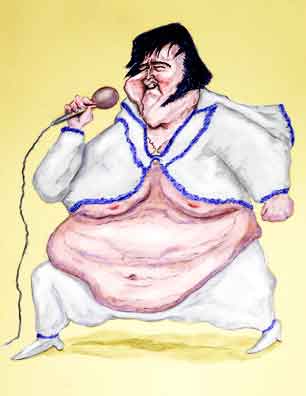
The Truck Driver From Memphis
Perhaps it was even more irritating when people did mention Bo's influence. There were musicians who readily admitted their debt to Bo who were earning incomes that rivaled the wealth of multi-national corporations. But by 1987 Bo was living in a trailer outside of Archer, Florida and shopping for clothes in bargain basements
Oh, don't worry. Bo was never out of work. Although he rarely received royalties for his recordings, he could always find performing jobs and he made enough to keep up his inventions and innovations. Through the last two decades of the 20th Century and into the first of the Millennium he appeared nigh on 50 times on television or in films. And he continued to tour and perform at festivals and concerts throughout the world. His last concert was on April 7, 2007 at the Bluesfest in Byron Bay, Australia.
So after the Millennium, Bo had achieved much of the recognition he was due. He was given the Achievement Award by Guitar Player Magazine and a Lifetime Achievement Award by the National Academy of Recording Arts and Sciences. He still, though, lived in his mobile home in Archer.
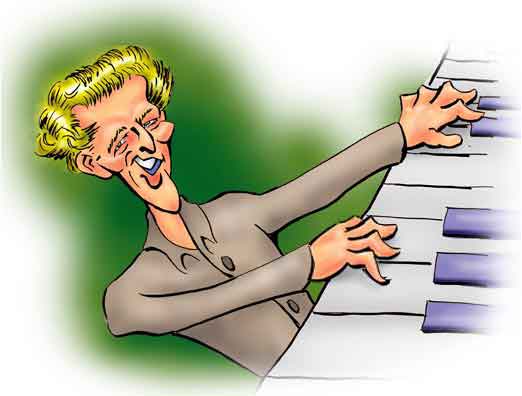
Jerry Lee Lewis ...
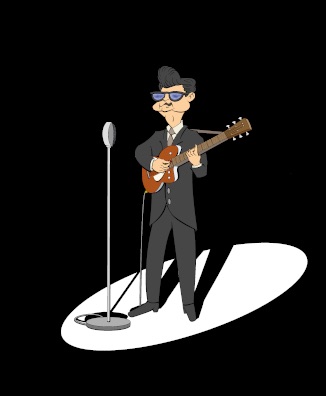
... Roy Orbison ...
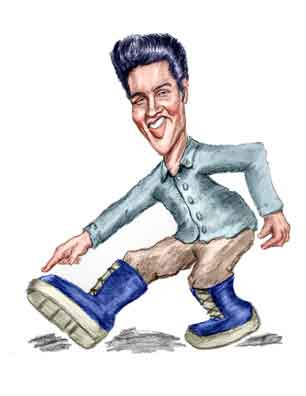
... and Elvis
They never received the honor.
Fortunately, though, Bo finally received the accolade he so merited with an honor above which no one can rise. True, he was inducted into the Rock and Roll Hall of Fame in 1987. But we're talking about an honor that only the select have achieved. Jerry Lee Lewis never received such recognition. Roy Orbison didn't achieve such recognition. Even Elvis never received such recognition.
Yes, not once, not twice, but three times, Bo Diddley was on Sesame Street.
References and Further Reading
The Dictionary of Global Culture, Anthony Appiah, Kwame Anthony Appiah, and Henry Louis Gates, Knopf, 1996.
The Guinness Who's Who of Blues, Colin Larkin, Guinness Publishing, 1993.
Where Are You Know, Bo Diddley, Edward Kiersh, Doubleday, 1986.
"Remembering Bo Diddley: 1928-2008", Alan Light, Rolling Stone,
June 27, 2008
"Bo Diddley", Famous African Americans.
"Bo Diddley", Encyclopedia Britannica, April 2, 2014 (Revised: March 26, 2021).
Bo Diddley: Rock & Roll All-Star, Greg Roza, Gareth Stevens Publishing, 2010, (Children's Book, 32pp.).
"Bo Diddley: The Rolling Stone Interview", Kurt Loder, Rolling Stone, Febrary 12, 1987.
"The Indestructible Beat of Bo Diddley", Neil Strauss, Rolling Stone, August 25, 2005.
"That’s spelled M-A-N", Alexander Billet, Socialist Worker, June 12, 2002.
"Bo Diddley", Billboard.
"Lady Bo: 'The Mother of the Electric Guitar'", Pierre Perrone, September 28, 2015.
"Bo Diddley Tours & Concerts", Concert Archives.
The Legend of Bo Diddley, Bo Diddley (Performer), Gary Sherman (Director), 1966.
Dancing in the Street: A Rock and Roll History", Robert Palmer (Writer), BBC, 1996.
"John Williams", Interview with Mark Davis, Guitar Player Magazine, 2005.
"Build a Diddley-Bow Stringed Musical Instrument", Science Works, June 4, 2020.
Railroad Magazine, Volumes 48-49, p. 117.
"Bo Diddley", Internet Movie Data Base.
"Sesame Street" Internet Movie Data Base.
"The Ed Sullivan Show" Internet Movie Data Base.
"The 10 Longest Putts Ever Holed", Will Trinkwon, September 2, 2019, Golf Shake.
"Michael Phelps' Other Claim to Fame? Making the Longest Televised Putt in History", Alex Myers, Golf Digest, August 10, 2016.
Wireless: From Marconi's Black-box to the Audion, Sungook Hong, MIT Press, 2001.
"The New Naval Advisory Board of Inventors", The Hattiesburg News, October 6, 1915, p. 3
"Inventor Chosen for Navy Board", Grand Forks Daily Herald, September 27, 1915, p. 6
"Secret of Wireless Telephone", Albuquerque Morning Journal, January 14, 1916, p. 6
"First Picture of Democratic National Convention", The [Albuquerque, New Mexico] Evening Herald, July 1, 1920, p. 1
Return to CooperToons Caricatures
Return to CooperToons Homepage



 BLUES. And most of all it was a city of the electric blues.
BLUES. And most of all it was a city of the electric blues.
